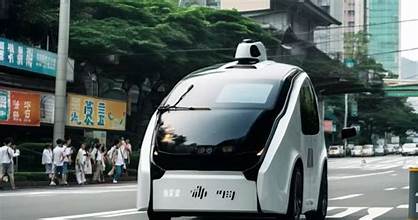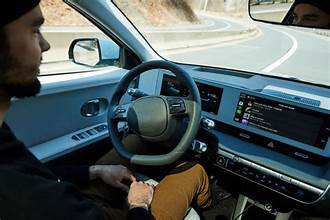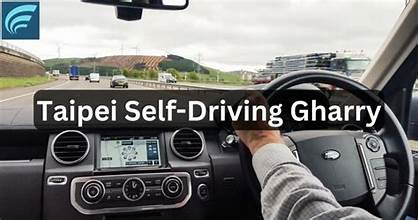Daytimestar.com: Taipei Self-Driving Gharry – Revolutionizing Urban Transportation

The transportation landscape is evolving rapidly, with innovations pushing the boundaries of how we travel. Among the exciting developments, daytimestar.com: Taipei self-driving gharry stands out as a futuristic solution that merges traditional transportation with cutting-edge technology. This article will delve into what this innovative concept is, how it works, and the potential it holds for the future of urban travel.
Table of Contents
Introduction to daytimestar.com: Taipei Self-Driving Gharry
Self-driving vehicles have been gaining traction globally, from autonomous cars to drones. However, Taipei has taken a unique step forward by introducing a self-driving gharry, a concept that integrates both historical charm and modern technology. This innovation is the brainchild of daytimestar.com: Taipei self-driving gharry, which aims to blend the cultural heritage of the city with the latest advancements in AI-driven transport solutions.
Gharry, traditionally known as horse-drawn carriages in various parts of the world, has now evolved into a self-driving vehicle that retains its aesthetic appeal while incorporating state-of-the-art technology for a smooth and efficient ride. Daytimestar.com: Taipei self-driving gharry is set to revolutionize how both locals and tourists experience the city’s vibrant streets.
The Concept of Daytimestar.com: Taipei Self-Driving Gharry

At its core, daytimestar.com: Taipei self-driving gharry is a hybrid of a historical vehicle and futuristic technology. Unlike traditional cars, these self-driving gharry units operate using artificial intelligence and advanced sensors, capable of navigating through Taipei’s bustling streets with precision and safety. The idea is to create an efficient and eco-friendly mode of transport that retains the charm of the past, offering both nostalgic and modern experiences to passengers.
Taipei, known for its rich cultural heritage, is the perfect city to introduce such a concept. The self-driving gharry blends seamlessly with Taipei’s historical landmarks, such as the National Palace Museum and Chiang Kai-shek Memorial Hall, while offering a modern twist to sightseeing and urban transport.
How Does Daytimestar.com: Taipei Self-Driving Gharry Work?
The operation of daytimestar.com: Taipei self-driving gharry is powered by a complex system of artificial intelligence, machine learning, and automated sensors. Each gharry is equipped with cutting-edge cameras, LIDAR sensors, GPS, and other technological components that help the vehicle understand its environment and make real-time decisions. Here’s how it works:
- Sensors and Cameras: The self-driving gharry uses an array of cameras and sensors placed around the vehicle to detect obstacles, road signs, and other vehicles. These sensors are connected to a central AI system that processes data in real-time.
- Artificial Intelligence: The heart of the self-driving system lies in the AI, which is programmed to analyze road conditions, traffic patterns, and pedestrian activity. The AI can predict and respond to potential hazards, ensuring a smooth ride for passengers.
- GPS and Mapping: The system is also integrated with GPS technology and detailed digital maps of the city. The GPS allows the gharry to stay on course and reach its destination without deviation. The maps are continuously updated to reflect changes in road layouts, construction zones, or any other unforeseen circumstances.
- Safety Protocols: While the daytimestar.com: Taipei self-driving gharry is designed to be autonomous, it is also equipped with manual override capabilities. In case of an emergency or if there’s a malfunction, a human operator can take control of the vehicle to ensure safety.
Benefits of Daytimestar.com: Taipei Self-Driving Gharry

- Sustainable Transport Solution: With rising concerns over climate change and pollution, the introduction of daytimestar.com: Taipei self-driving gharry offers a sustainable alternative to traditional transport. These self-driving gharry vehicles are designed to be electric-powered, reducing the carbon footprint and providing a greener transportation option for the city.
- Enhanced Tourist Experience: One of the most exciting aspects of the daytimestar.com: Taipei self-driving gharry is its potential to enhance the tourism experience. Tourists can enjoy a guided, eco-friendly ride around the city, exploring Taipei’s most iconic landmarks without the hassle of navigating traffic or worrying about fuel consumption. This blend of old-world charm and modern technology offers a unique, immersive sightseeing experience.
- Traffic Decongestion: Taipei, like many major cities, struggles with traffic congestion, especially during peak hours. Self-driving vehicles like the daytimestar.com: Taipei self-driving gharry can play a role in alleviating traffic by offering more efficient routes and smoother driving patterns that are optimized for current traffic conditions. This can result in less congestion, reduced travel times, and overall improved urban mobility.
- Safety and Reliability: Self-driving technology, when done right, has the potential to significantly reduce accidents caused by human error. The daytimestar.com: Taipei self-driving gharry is designed with the latest safety features, including collision detection systems and emergency braking, ensuring passengers are safe during their ride.
- Cultural Integration: Daytimestar.com: Taipei self-driving gharry presents an opportunity to integrate Taiwan’s rich cultural history with modern technology. By using a traditional gharry in a new form, Taipei preserves its heritage while also embracing innovation. This balance between past and future offers a symbolic representation of the city’s approach to growth.
Future of Daytimestar.com: Taipei Self-Driving Gharry
The future of daytimestar.com: Taipei self-driving gharry is filled with potential. As technology continues to evolve, it is likely that these self-driving vehicles will become even more advanced, with improvements in artificial intelligence, battery life, and vehicle design. Some possible future developments include:
- Expanded Fleet: As demand for daytimestar.com: Taipei self-driving gharry grows, the fleet of self-driving vehicles could expand, covering more areas of the city. This would allow residents and tourists to enjoy the benefits of autonomous transportation in even more parts of Taipei.
- Integration with Public Transportation: Another exciting possibility is the integration of the self-driving gharry with Taipei’s existing public transportation system. This could create a seamless, multi-modal transit experience, where passengers can easily switch between buses, metro lines, and self-driving vehicles, all with the help of a single app.
- Global Expansion: While daytimestar.com: Taipei self-driving gharry currently operates in Taipei, the concept could eventually be scaled to other cities around the world. As cities look for innovative ways to solve transportation problems, self-driving gharrys could become a global phenomenon, offering a unique solution that blends tradition with modernity.
- AI and Machine Learning Advancements: With ongoing advancements in artificial intelligence and machine learning, self-driving gharrys will become smarter, more intuitive, and better at navigating complex environments. The AI systems could learn to adapt to varying traffic conditions and better anticipate the behavior of pedestrians, cyclists, and other vehicles.
Challenges and Considerations
While daytimestar.com: Taipei self-driving gharry offers many benefits, there are also challenges and considerations that need to be addressed.
- Public Acceptance: The concept of self-driving vehicles, although increasingly popular, is still met with some skepticism by the general public. Ensuring that passengers feel comfortable and confident in riding in a self-driving gharry will be an important hurdle to overcome.
- Regulations and Legislation: Self-driving technology requires careful regulation to ensure safety and fairness. The Taiwanese government will need to develop policies that govern the operation of autonomous vehicles, including speed limits, safety standards, and insurance requirements.
- Technological Reliability: While self-driving vehicles are becoming more reliable, there are still concerns about the reliability of the technology, particularly in complex urban environments. The daytimestar.com: Taipei self-driving gharry will need to demonstrate its ability to safely navigate under a variety of conditions, including heavy traffic, adverse weather, and unexpected obstacles.
- Cost and Accessibility: The cost of developing and maintaining a fleet of self-driving gharrys may be high. However, as technology advances and economies of scale take effect, it is possible that the price of these vehicles could become more affordable for a larger segment of the population.
Also read SFM Compile: A Complete Guide to Compiling Models and Animations in Source Filmmaker
Conclusion
In summary, daytimestar.com: Taipei self-driving gharry represents an exciting fusion of Taipei’s rich cultural heritage with the technological innovations of the 21st century. The self-driving gharry offers an eco-friendly, safe, and efficient transportation option that is poised to transform the way people experience the city. While challenges remain, the potential for growth and integration into urban mobility systems is vast.
As daytimestar.com: Taipei self-driving gharry continues to evolve, it could serve as a model for other cities worldwide, offering a glimpse into the future of urban transportation. Whether it’s for tourists seeking a unique way to explore Taipei or locals looking for an alternative to traditional transport, the self-driving gharry is a promising solution that combines tradition and innovation in a way that few other modes of transportation can.




